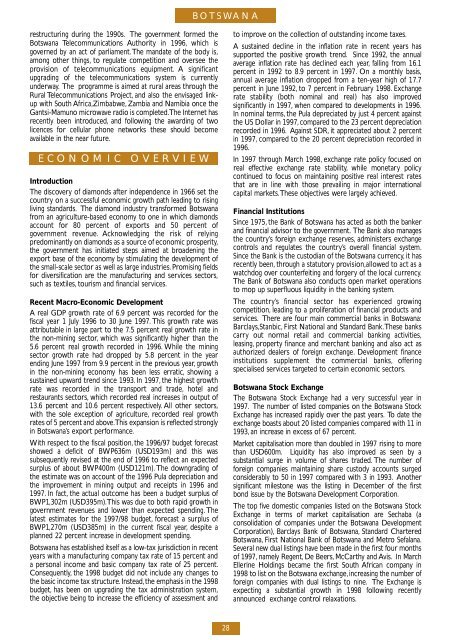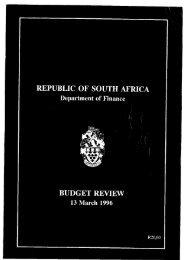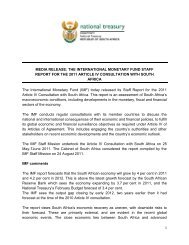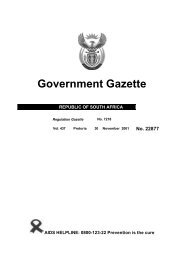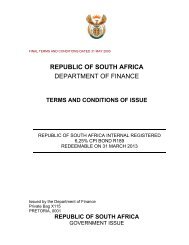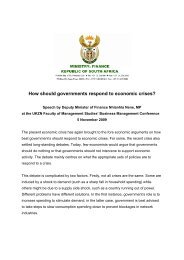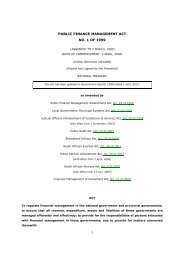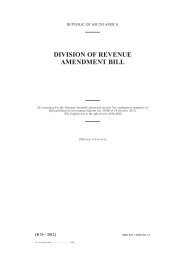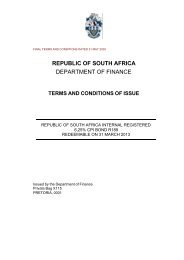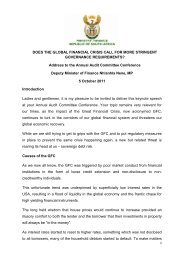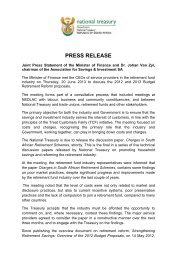1998 SOUTHERN AFRICA ECONOMIC ... - National Treasury
1998 SOUTHERN AFRICA ECONOMIC ... - National Treasury
1998 SOUTHERN AFRICA ECONOMIC ... - National Treasury
Create successful ePaper yourself
Turn your PDF publications into a flip-book with our unique Google optimized e-Paper software.
B O T S WA N A<br />
restructuring during the 1990s. The government formed the<br />
B o t swana Te l e c o m munications Authority in 1996, which is<br />
governed by an act of parliament.The mandate of the body is,<br />
among other things, to regulate competition and oversee the<br />
p rovision of telecommunications equipment. A significant<br />
upgrading of the telecommunications system is curre n t ly<br />
u n d e r w ay. The programme is aimed at rural areas through the<br />
Rural Te l e c o m munications Pro j e c t ,and also the envisaged linkup<br />
with South A f r i c a ,Z i m b a b we, Zambia and Namibia once the<br />
G a n t s i - M a muno microw ave radio is completed.The Internet has<br />
re c e n t ly been intro d u c e d , and fo l l owing the aw a rding of two<br />
licences for cellular phone networks these should become<br />
available in the near future.<br />
E C O N O M I C O V E R V I E W<br />
I n t ro d u c t i o n<br />
The discove ry of diamonds after independence in 1966 set the<br />
c o u n t ry on a successful economic growth path leading to rising<br />
living standard s . The diamond industry transformed Botsw a n a<br />
f rom an agriculture-based economy to one in which diamonds<br />
account for 80 percent of exports and 50 percent of<br />
government reve nu e. A c k n owledging the risk of re ly i n g<br />
p re d o m i n a n t ly on diamonds as a source of economic pro s p e r i t y,<br />
the government has initiated steps aimed at broadening the<br />
e x p o rt base of the economy by stimulating the development of<br />
the small-scale sector as well as large industries. P romising fields<br />
for diversification are the manufacturing and services sectors,<br />
such as textiles, tourism and financial serv i c e s .<br />
Recent Macro-Economic Deve l o p m e n t<br />
A real GDP growth rate of 6.9 percent was re c o rded for the<br />
fiscal year 1 Ju ly 1996 to 30 June 1997. This growth rate was<br />
attributable in large part to the 7.5 percent real growth rate in<br />
the non-mining sector, which was significantly higher than the<br />
5.6 percent real growth re c o rded in 1996. While the mining<br />
sector growth rate had dropped by 5.8 percent in the ye a r<br />
ending June 1997 from 9.9 percent in the previous ye a r, g row t h<br />
in the non-mining economy has been less err a t i c, s h owing a<br />
sustained upward trend since 1993. In 1997, the highest grow t h<br />
rate was re c o rded in the transport and trade, hotel and<br />
restaurants sectors, which re c o rded real increases in output of<br />
13.6 percent and 10.6 percent re s p e c t i ve ly. All other sectors,<br />
with the sole exception of agriculture, re c o rded real grow t h<br />
rates of 5 percent and above.This expansion is reflected stro n g ly<br />
in Botsw a n a ’s export perfo r m a n c e.<br />
With respect to the fiscal position, the 1996/97 budget fo re c a s t<br />
s h owed a deficit of BWP636m (USD193m) and this was<br />
s u b s e q u e n t ly revised at the end of 1996 to reflect an expected<br />
surplus of about BWP400m (USD121m).The downgrading of<br />
the estimate was on account of the 1996 Pula depreciation and<br />
the improvement in mining output and receipts in 1996 and<br />
1 9 9 7 .In fact, the actual outcome has been a budget surplus of<br />
BWP1,302m (USD395m).This was due to both rapid growth in<br />
government reve nues and lower than expected spending. T h e<br />
latest estimates for the 1997/98 budget, fo recast a surplus of<br />
BWP1,270m (USD385m) in the current fiscal ye a r, despite a<br />
planned 22 percent increase in development spending.<br />
B o t swana has established itself as a low-tax jurisdiction in re c e n t<br />
years with a manufacturing company tax rate of 15 percent and<br />
a personal income and basic company tax rate of 25 perc e n t .<br />
C o n s e q u e n t ly, the <strong>1998</strong> budget did not include any changes to<br />
the basic income tax structure. I n s t e a d ,the emphasis in the <strong>1998</strong><br />
b u d g e t ,has been on upgrading the tax administration system,<br />
the objective being to increase the efficiency of assessment and<br />
to improve on the collection of outstanding income taxe s .<br />
A sustained decline in the inflation rate in recent years has<br />
s u p p o rted the positive growth tre n d . Since 1992, the annu a l<br />
average inflation rate has declined each ye a r, falling from 16.1<br />
p e rcent in 1992 to 8.9 percent in 1997. On a monthly basis,<br />
a n nual average inflation dropped from a ten-year high of 17.7<br />
p e rcent in June 1992, to 7 percent in Fe b r u a ry <strong>1998</strong>. E x c h a n g e<br />
rate stability (both nominal and real) has also improve d<br />
s i g n i f i c a n t ly in 1997, when compared to developments in 1996.<br />
In nominal terms, the Pula depreciated by just 4 percent against<br />
the US Dollar in 1997, c o m p a red to the 23 percent depre c i a t i o n<br />
re c o rded in 1996. Against SDR, it ap p reciated about 2 perc e n t<br />
in 1997, c o m p a red to the 20 percent depreciation re c o rded in<br />
1 9 9 6 .<br />
In 1997 through March <strong>1998</strong>, exchange rate policy focused on<br />
real effe c t i ve exchange rate stability, while monetary policy<br />
c o n t i nued to focus on maintaining positive real interest rates<br />
that are in line with those prevailing in major international<br />
c apital marke t s .These objectives we re largely achieve d .<br />
Financial Institutions<br />
Since 1975, the Bank of Botswana has acted as both the banke r<br />
and financial advisor to the gove r n m e n t .The Bank also manages<br />
the country ’s fo reign exchange re s e rve s , administers exchange<br />
c o n t rols and regulates the country ’s overall financial system.<br />
Since the Bank is the custodian of the Botswana curre n c y, it has<br />
re c e n t ly been, t h rough a statutory prov i s i o n ,a l l owed to act as a<br />
watchdog over counterfeiting and fo r g e ry of the local curre n c y.<br />
The Bank of Botswana also conducts open market operations<br />
to mop up superfluous liquidity in the banking system.<br />
The country ’s financial sector has experienced grow i n g<br />
c o m p e t i t i o n ,leading to a pro l i feration of financial products and<br />
s e rv i c e s . T h e re are four main commercial banks in Botsw a n a :<br />
B a rc l ay s ,S t a n b i c, First <strong>National</strong> and Standard Bank.These banks<br />
c a rry out normal retail and commercial banking activities,<br />
l e a s i n g ,p ro p e rty finance and merchant banking and also act as<br />
authorized dealers of fo reign exchange. D evelopment finance<br />
institutions supplement the commercial banks, o f fe r i n g<br />
specialised services targeted to certain economic sectors.<br />
B o t swana Stock Exchange<br />
The Botswana Stock Exchange had a ve ry successful year in<br />
1 9 9 7 . The number of listed companies on the Botswana Stock<br />
Exchange has increased rap i d ly over the past ye a r s . To date the<br />
exchange boasts about 20 listed companies compared with 11 in<br />
1 9 9 3 ,an increase in excess of 67 perc e n t .<br />
M a r ket capitalisation more than doubled in 1997 rising to more<br />
than USD600m. Liquidity has also improved as seen by a<br />
substantial surge in volume of shares traded. The number of<br />
fo reign companies maintaining share custody accounts surged<br />
c o n s i d e r a b ly to 50 in 1997 compared with 3 in 1993. A n o t h e r<br />
significant milestone was the listing in December of the first<br />
bond issue by the Botswana Development Corporation.<br />
The top five domestic companies listed on the Botswana Stock<br />
Exchange in terms of market capitalisation are Sechaba (a<br />
consolidation of companies under the Botswana Deve l o p m e n t<br />
C o r p o r a t i o n ) ,B a rc l ays Bank of Botsw a n a ,S t a n d a rd Chart e re d<br />
B o t sw a n a ,First <strong>National</strong> Bank of Botswana and Metro Sefalana.<br />
S everal new dual listings have been made in the first four months<br />
of 1997, n a m e ly Regent, De Beers, M c C a rt hy and Av i s . In Marc h<br />
Ellerine Holdings became the first South African company in<br />
<strong>1998</strong> to list on the Botswana exchange,i n c reasing the number of<br />
fo reign companies with dual listings to nine. The Exchange is<br />
expecting a substantial growth in <strong>1998</strong> fo l l owing re c e n t ly<br />
announced exchange control re l a x a t i o n s .<br />
28


